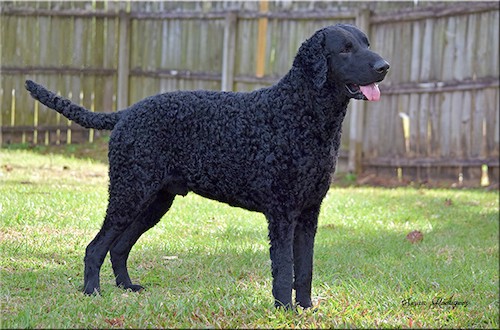
"Daryl came from England to the USA on loan to Tyneside Curlies in Florida. He was in the US for 18 months before returning home."
kur-lee koh-tid ri-tree-ver 
The Curly-Coated Retriever is a large, hardy dog, whose body is slightly longer than it is tall. The head is longer than it is wide. The topline is level and the neck is strong and slightly arched. The muzzle is wedge-shaped and tapered, rounding at the bottom. The stop is shallow and sloping. The nose is black on black dogs and brown on liver dogs, with wide nostrils. The teeth meet in a scissors bite. The hanging ears are somewhat small. The large, predominant, almond-shaped eyes are black or brown in black dogs and brown or amber in liver-colored dogs. The chest is deep and not too wide. The tail reaches approximately to the hock and is covered in curly hair, carried straight or almost straight and is never docked. When the curls on the tail are trimmed the tail tapers to a point. Dewclaws are usually removed. The water-resistant coat very distinct with small, tight curls that cover every part of the body except for the forehead, face, front of forelegs and feet. The coat protects the dog from brambles and icy waters. Coat colors come in black or liver. The coat may have a small white patch, but it is not desired in the show ring.
The Curly-Coated Retriever is easy to get along with, loyal and eager to please. Proud and confident, very intelligent and trainable, be sure to thoroughly obedience train your dog starting from puppyhood. They have been used in competitive obedience and agility, but are not as predictable as some other breeds. This is not a breed for everyone. They do not fully mature until they are about three years old and can be willful with meek owners. Make sure you are the dog's firm, but confident, consistent pack leader to bring out the best in its temperament. Proper canine to human communication is essential. The Curly-Coated Retriever is affectionate, loving and excellent with children. The more mental and physical exercise you give it, the calmer it will be. Socialize them well with people and other pets at an early age. Without proper balance in its life, it can be reserved or timid with strangers. This breed loves to swim. They make good therapy dogs. Curly-Coated Retrievers make an ideal partner for an active, outdoor-oriented person who also wants a loyal family companion. They make good watch and even guard dogs if they see the family is threatened.
Height: 25 - 27 inches (63 - 69 cm)
Weight: 65 - 80 pounds (29 - 36 kg)
Prone to hip dysplasia, epilepsy and eye problems.
The Curly-Coated Retriever is not recommended for apartment life. It does best with at least a large yard. An eager and tireless land and (especially) water retriever outdoors, but a calm companion indoors. Curlies need to be part of the family and not left alone outside in the yard all day.
The Curly-Coated Retriever is a high-energy, but also very intelligent dog that needs a lot of exercise, both mental and physical, preferably involving swimming and retrieving. It needs to be taken on a daily long brisk walk, or jog, where the dog is made to heel beside or behind the human holding the lead, as in a dog's mind the leader leads the way and that leader needs to be the humans.
About 8-12 years.
About 7 to 8 puppies
The curly coat is easy to care for. Bathe when necessary. Brushing and combing is not recommended as it makes the coat frizzy; if this happens simply wet the coat again and let it air dry. Some minimal scissoring may be desirable to tidy up scraggly hairs. It does need regular brushing during its shedding seasons. This breed is an average shedder.
The Curly-Coated Retriever is considered to be one of the oldest retriever breeds. It has been used for retrieving as long ago as the late eighteenth century in England, where it was developed. The breed descended from the English Water Spaniel, the St. John's Newfoundland, the retrieving setter, the Poodle and possibly the Irish Water Spaniel and the Labrador. The Curly-Coated Retriever is an excellent hunting companion and gun dog, waterfowl retriever and upland game hunter, with a gentle mouth. They were often used to hunt duck and quail. The breed is pretty rare inside the USA but is more popular in Australia and New Zealand. The first exports to America were in 1907. The Curly-Coated Retriever was recognized by the AKC in 1924. This breed may take some effort to find. Some of the Curly's talents are hunting, tracking, retrieving, watchdog, guarding, agility and competitive obedience.
Gun Dog, AKC Sporting Group

"Dillon is a 6 month old liver curly at Tyneside Curlies in Florida."

"Black and liver colored 6 week old curly puppies at Tyneside Curlies."
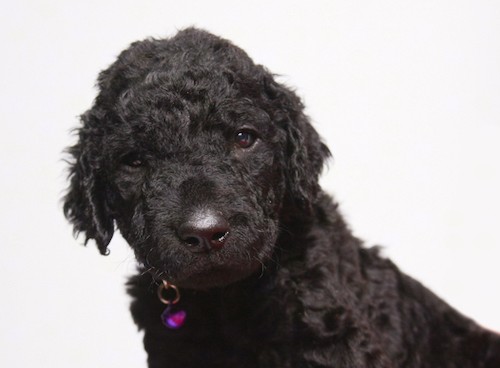
"The sweet face of a 5 week old black curly baby from Tyneside Curlies"
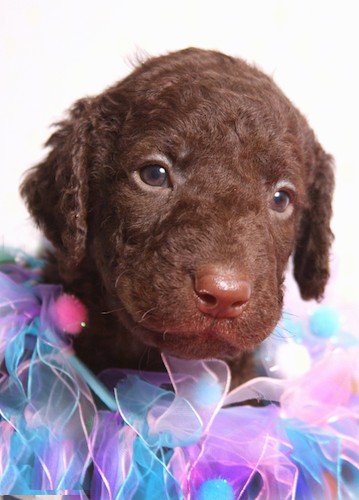
"This baby face belongs to 5 week old Eve at Tyneside Curlies."
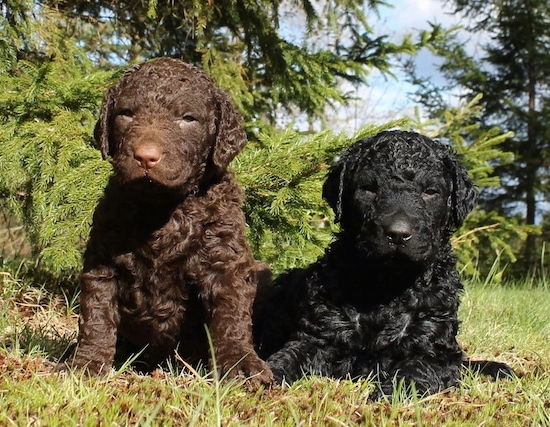
SoftMaple Curly Coated Retriever puppies at 5 weeks old. The pup on the left is a liver color and the pup on the right is black. They are brother and sister. It looks like they are holding paws.
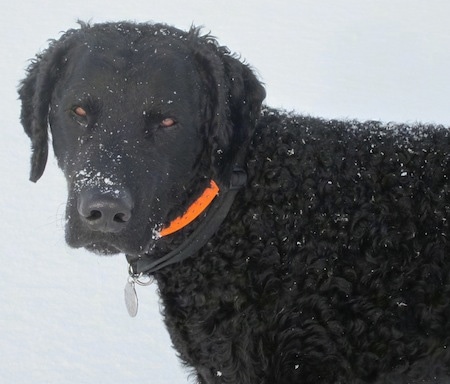
Reuben the Curly-Coated Retriever at 3 years old—"He is a gentle family companion."